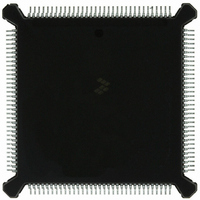MC68332GCEH16 Freescale Semiconductor, MC68332GCEH16 Datasheet - Page 125

MC68332GCEH16
Manufacturer Part Number
MC68332GCEH16
Description
IC MCU 32BIT 16MHZ 132-PQFP
Manufacturer
Freescale Semiconductor
Series
M683xxr
Specifications of MC68332GCEH16
Core Processor
CPU32
Core Size
32-Bit
Speed
16MHz
Connectivity
EBI/EMI, SCI, SPI, UART/USART
Peripherals
POR, PWM, WDT
Number Of I /o
15
Program Memory Type
ROMless
Ram Size
2K x 8
Voltage - Supply (vcc/vdd)
4.5 V ~ 5.5 V
Oscillator Type
Internal
Operating Temperature
-40°C ~ 85°C
Package / Case
132-QFP
Cpu Family
68K/M683xx
Device Core
ColdFire
Device Core Size
32b
Frequency (max)
16MHz
Interface Type
QSPI/SCI/UART
Program Memory Size
Not Required
Total Internal Ram Size
2KB
# I/os (max)
15
Number Of Timers - General Purpose
16
Operating Supply Voltage (typ)
5V
Operating Supply Voltage (max)
5.5V
Operating Supply Voltage (min)
4.5V
Instruction Set Architecture
RISC
Operating Temp Range
-40C to 85C
Operating Temperature Classification
Industrial
Mounting
Surface Mount
Pin Count
132
Package Type
PQFP
Controller Family/series
68K
No. Of I/o's
15
Ram Memory Size
2KB
Cpu Speed
16MHz
No. Of Timers
16
Embedded Interface Type
QSPI, SCI, UART
Digital Ic Case Style
PQFP
Rohs Compliant
Yes
Processor Series
M683xx
Core
CPU32
Data Bus Width
32 bit
Data Ram Size
2 KB
Maximum Clock Frequency
16 MHz
Number Of Programmable I/os
15
Number Of Timers
16
Maximum Operating Temperature
+ 85 C
Mounting Style
SMD/SMT
Minimum Operating Temperature
- 40 C
Lead Free Status / RoHS Status
Lead free / RoHS Compliant
Eeprom Size
-
Program Memory Size
-
Data Converters
-
Lead Free Status / Rohs Status
Compliant
Available stocks
Company
Part Number
Manufacturer
Quantity
Price
Company:
Part Number:
MC68332GCEH16
Manufacturer:
Freescale Semiconductor
Quantity:
10 000
6.2.1.2 Freeze Operation
6.2.1.3 QSM Interrupts
6.2.2 QSM Pin Control Registers
MC68332
USER’S MANUAL
The freeze (FRZ[1:0]) bits in the QSMCR are used to determine what action is taken
by the QSM when the IMB FREEZE signal is asserted. FREEZE is asserted when the
CPU enters background debugging mode. At the present time, FRZ0 has no effect;
setting FRZ1 causes the QSPI to halt on the first transfer boundary following FREEZE
assertion. Refer to SECTION 5 CENTRAL PROCESSING UNIT for more information
about background debugging mode.
Both the QSPI and SCI can make interrupt requests on the IMB. Each has a separate
interrupt request priority register, but a single vector register is used to generate ex-
ception vector numbers.
The values of the ILQSPI and ILSCI fields in the QILR determine the priority of QSPI
and SCI interrupt requests. The values in these fields correspond to internal interrupt
request signals IRQ[7:1]. A value of %111 causes IRQ7 to be asserted when a QSM
interrupt request is made; lower field values cause corresponding lower-numbered in-
terrupt request signals to be asserted. Setting field value to %000 disables interrupts.
If ILQSPI and ILSCI have the same nonzero value, and the QSPI and SCI make simul-
taneous interrupt requests, the QSPI has priority.
When the CPU32 acknowledges an interrupt request, it places the value in the inter-
rupt priority (IP) mask in the CPU status register on the address bus. The QSM com-
pares IP mask value to request priority to determine whether it should contend for
arbitration priority. Arbitration priority is determined by the value of the IARB field in the
QSMCR. Each module that generates interrupts must have a nonzero IARB value. Ar-
bitration is performed by means of serial assertion of IARB field bit values.
When the QSM wins interrupt arbitration, it responds to the CPU interrupt acknowl-
edge cycle by placing an interrupt vector number on the data bus. The vector number
is used to calculate displacement into the CPU32 exception vector table. SCI and
QSPI vector numbers are generated from the value in the QIVR INTV field. The values
of bits INTV[7:1] are the same for QSPI and SCI, but the value of INTV0 is supplied by
the QSM when an interrupt request is made. INTV0 = 0 for SCI interrupt requests;
INTV0 = 1 for QSPI requests.
At reset, INTV is initialized to $0F, the uninitialized interrupt vector number. To enable
interrupt-driven serial communication, a user-defined vector number ($40–$FF) must
be written to QIVR, and interrupt handler routines must be located at the addresses
pointed to by the corresponding vector. CPU writes to INTV0 have no meaning or ef-
fect. Reads of INTV0 return a value of one.
Refer to SECTION 5 CENTRAL PROCESSING UNIT and SECTION 4 SYSTEM IN-
TEGRATION MODULE for more information about exceptions and interrupts.
The QSM uses nine pins. Eight of the pins can be used for serial communication or for
parallel I/O. Clearing a bit in the port QS pin assignment register (PQSPAR) assigns
Freescale Semiconductor, Inc.
For More Information On This Product,
QUEUED SERIAL MODULE
Go to: www.freescale.com
6-3











